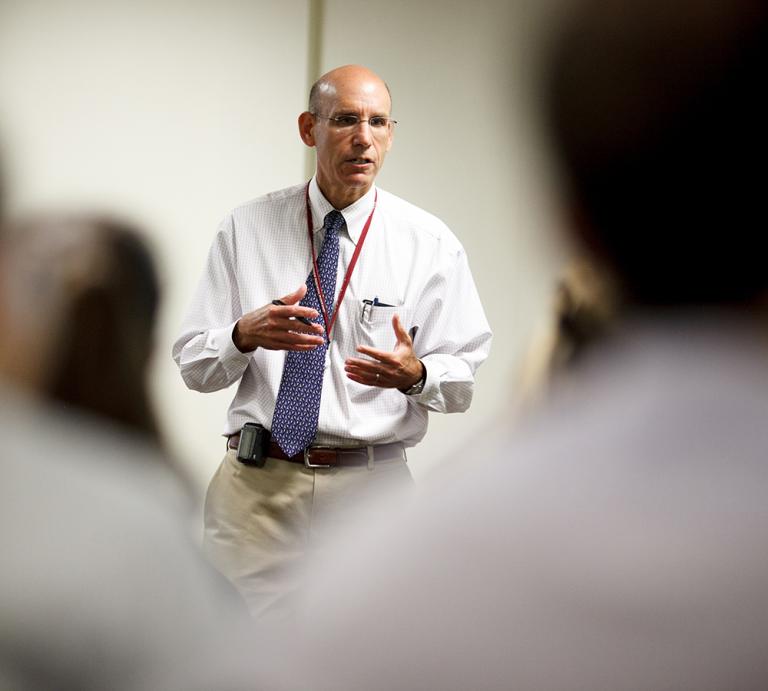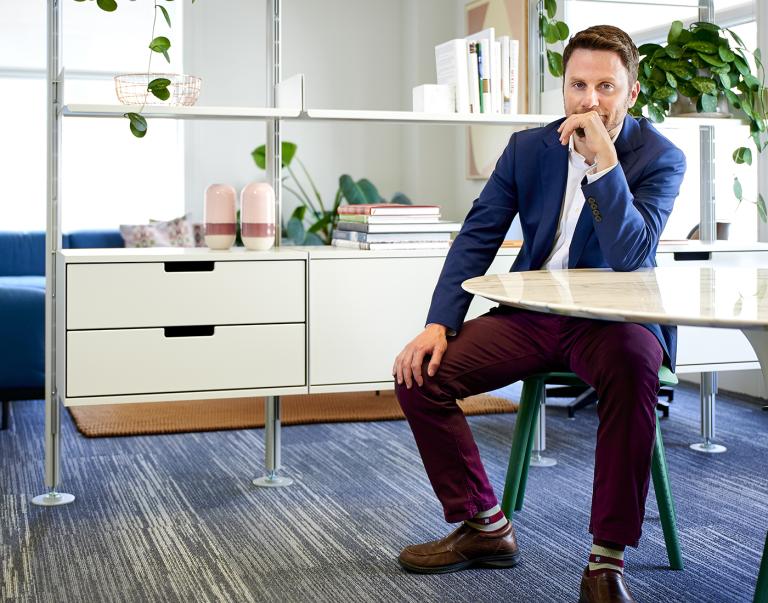Adaptive Learning
Medical education needs to use a long lens when preparing young doctors for careers in primary care
The Business of Medicine Issue
- Feature

Nearly a decade ago, the passage of the Affordable Care Act galvanized monumental changes in the U.S. health care system for patients and providers alike, beginning with expanded health care coverage for 20 million people in this country. The new models of care that formed the foundation of the ACA highlighted the potential of team-based primary care to tackle preventive care and population medicine while also managing costs.
This move toward team-based care may also reflect a demographic necessity. The Association of American Medical Colleges (AAMC) predicts a primary care physician shortage of between 21,100 and 55,200 physicians by 2032. Coupled with that prediction is its estimate that, in the same period, the number of physician assistants and advanced practice registered nurses will double. It’s likely, then, that some of the care traditionally provided by physicians will come from allied advanced practice providers.
Faced with such challenges and change, how is medical education responding? How are curricula being revamped to better provide future physicians with the skills needed to navigate the evolving demands of the profession?
Study one, teach one
These are questions Richard Schwartzstein, MD ’79, thinks about a great deal. In the early 2000s, Schwartzstein, the Ellen and Melvin Gordon Professor of Medical Education at Beth Israel Deaconess Medical Center and the director of educational scholarship at HMS, and his colleagues began to notice that HMS students seemed less engaged with the curriculum. Call it the google effect: When it came to gaining factual information, the ease of acquiring facts with the stroke of a key was soon at cross-purposes with the holistic approaches to learning essential for developing clinical reasoning skills. In addition, a lecture-heavy curriculum that placed basic science in the first two years, followed by more patient-focused courses in the third and fourth years, unwittingly reinforced the separation between scientific and clinical knowledge.
HMS medical educators weren’t alone in noticing these trends. In 2004 the AAMC reported that the design, content, and form of medical education lagged changes in the biomedical sciences, the way health care was organized and delivered, and society’s expectations of medicine and health care. The organization called for a more integrated, interdisciplinary, and patient-centered curriculum.

In 2007, under Schwartzstein’s leadership, HMS hosted a conference sponsored by the AAMC and the Carl J. Shapiro Institute for Education and Research at Beth Israel Deaconess, which led to the creation of a national medical education research agenda and kick-started research into curriculum change.
Traditionally, research in medical education had been more descriptive than scientific. Schwartzstein helped pioneer an empirical approach to medical education, using experimental studies to test educational innovations and ensure that new approaches to teaching will lead to more competent physicians and better patient outcomes.
Then came Educating Physicians: A Call for Reform of Medical School and Residency, published in 2010 by the Carnegie Foundation for the Advancement of Teaching. The report appeared one century after Abraham Flexner’s noted critique of U.S. medical education. That critique set the stage for the now-familiar system of science-based academic medical education and university teaching hospitals. The Carnegie study, by contrast, found that medical school curricula nationwide were overly focused on mastering facts. The study’s authors wrote that curricula lacked connection between “formal knowledge and experiential learning.” The authors also found inadequate attention to patient populations, health care delivery, and the effectiveness of various diagnostic and therapeutic interventions, and they worried that doctors-in-training did not fully understand the broader civic and advocacy roles of physicians.
The path taken
At HMS the Carnegie report kindled discussions over the shape of undergraduate medical education and sparked evidence-based research on curriculum design. The result: the Pathways curriculum, launched in 2015.
On a more philosophical level, however, the Carnegie report prompted HMS educators to reflect on what it means to be a well-trained physician when the practice of medicine is continually changing.
“It’s my belief that we shouldn’t be focused entirely on putting out a doctor who’s perfectly trained to practice tomorrow,” Schwartzstein says. “Our students are going to have careers that span several decades. Whatever it is that they’re prepared for on day one of residency is not going to be what they’re going to do five years later, let alone thirty-five years later.”
Schwartzstein is a proponent of what he calls the “liberal arts equivalent” of medicine and favors encouraging students to pursue a broad-based foundation upon which they can layer specialization. He cites his own training as an example. Although Schwartzstein now practices internal medicine and pulmonology, as a medical student he took rotations in ophthalmology, sports medicine, and dermatology to complement the more specialized training he would receive during residency.
“Medicine is a profession and that carries with it ethical, moral, and scientific obligations for how we prepare ourselves for this long career. We have to be able to continue our growth and development as learners,” he says.
One aspect of the evolving health care system that’s on Schwartzstein’s mind when it comes to educating the next generation of physicians is the rise of team-based care.
“In a health care system in which doctors are likely to be supervising teams of other health care professionals, they’re going to need to be able to recognize subtleties in data or cases being presented to them by others and to avoid framing bias,” he explains.
Schwartzstein also thinks it’s important to nurture essential habits of mind. Curiosity, critical thinking, and integrity are trademark qualities, he says, that will allow the next generation of doctors to provide high-quality care no matter what the health care system of the future looks like.
The future of learning at HMS, Schwartzstein says, will be both iterative and shaped by evidence-based research on what works best in medical education. The past decade of curriculum reform follows a tradition of professional introspection spawned by Flexner. It is by necessity a level of change that can come only from the top of the profession.
Inside, out
Grassroots change, however, comes from throughout the ranks.
In 2009, at the same time that Schwartzstein and other leaders in medical education were reflecting on how to make the medical school curriculum more responsive to transformations in health care, Andrew Morris-Singer, MD ’07, then a second-year internal medicine resident at Brigham and Women’s Hospital, was thinking about how to meet medicine’s need for change in care delivery, specifically in primary care.

At the time, says Morris-Singer, HMS had just proposed suspending funding for its Division of Primary Care as part of an administrative restructuring plan. Given that the nation was in the throes of debates that would result in the ACA, it was a decision Morris-Singer remembers as being “out of sync with where the country and our health care system needed to go.” Together with other HMS students and medical residents, he formed the Harvard Primary Care Reform Working Group in the hope of appealing to HMS leaders to restore funding. There was a petition drive, followed by town hall-style meetings.
A large-scale review, led by a former dean of the School, resulted in the creation of the HMS Center for Primary Care in 2011. Morris-Singer is an affiliated faculty member of the center.
The model for Morris-Singer’s approach to advocating for primary care originated with his experience as an organizer in communities facing anti-LGBTQ ballot measures. As an LGBTQ community organizer, he says, he learned the power of mobilizing diverse groups of people around shared interests and “the importance of someone understanding their own ecosystem.” Although the goal of community organizing is to effect change, he came to realize that cultivating “mind-set shifts and new narratives among stakeholders and decision makers” was a necessary precondition to establishing significant change.
The working group drew the attention of students at other U.S. medical schools, and Morris-Singer began to think more broadly about what it would take for health care providers to see themselves as agents of change. This thinking led to his founding, and now leading, Primary Care Progress.
Drawing on social movement strategies and social psychology research, PCP’s programs teach leadership and teamwork skills to medical students, physicians, and allied health care providers that will help them navigate a health care system that expects increased productivity and patient satisfaction while also expecting providers to grapple with declining reimbursement and large-scale adoption of electronic health records—all workplace factors that contribute to what many describe as an epidemic of burnout in the profession.
The new guard
Some of the skills vital to navigating this change, says Morris-Singer, fall within a concept known as “relational leadership.”
“A relational leader is someone who doesn’t just focus on the what and how of their work, they focus on who,” he explains. Relational leadership isn’t a fixed position, instead it’s a “mind-set and interpersonal orientation” available to all health care providers depending on context.
Think of it as a series of concentric circles with a medical student, physician, or other primary health care provider at the center. When providers apply growing self-knowledge to improve how they work in groups, their ability to communicate and collaborate is strengthened, they are less susceptible to burnout, and their positive influence frequently brings out the best in colleagues.
The potential of relational leadership doesn’t stop there, according to Morris-Singer. When health care providers gain greater insights into how they learn and work in teams, they also become more collaborative, innovative, and strategic contributors to those teams. They become better prepared to advocate for change and spur innovation from inside the systems in which they work. The same tools that allow medical students to pilot primary care programs during residency, he says, can be used by established physicians to initiate change in their practice groups.
PCP’s academic programs run on two tracks adjacent to formal medical school curricula and are founded upon the leadership development strategy that underpins the organization’s Relational Leadership Institute. Its Student Action Network serves as an umbrella for a variety of interprofessional student programs, including collaborations with the American Academy of Family Physicians, which focuses on family medicine through the Primary Care Leadership Collaborative, and with the Interprofessional Student Hotspotting Learning Collaborative.
“A relational leader is someone who doesn’t just focus on the what and how of their work, they focus on who.”
According to the Camden Coalition of Healthcare Providers, the student hotspotting collaborative is an annual program that aims to train interdisciplinary teams of professional students to use a patient-centric approach when working with individuals with complex medical and social needs. PCP co-hosts the collaborative; other co-hosts include the Camden Coalition, the AAMC, the National Academies of Practice, the Council on Social Work Education, and the American Association of Colleges of Nursing.
PCP also sponsors and coaches seventeen U.S. university-based student cohorts. At HMS, for example, the Center for Primary Care Student Leadership Committee (SLC) has been part of PCP since the nonprofit committee was founded.
According to Russell Phillips, the director of the School’s Center for Primary Care and the William Applebaum Professor of Medicine at Beth Israel Deaconess, the SLC grew out of the student group that advocated for the creation of the HMS center.
“That spirit of advocacy continues within the SLC,” says Phillips. “Today we work to empower students to become leaders and innovators in primary care. The committee provides a platform for interprofessional dialogue and collaboration, crucial for establishing team-based problem-solving skills the students will enhance throughout their careers.”
The SLC’s current community-based project is advised by Sara Selig, an associate director for the Community Outreach and Patient Empowerment Program, the domestic affiliate of Partners In Health, and based at Brigham and Women’s Hospital. Selig is an HMS instructor in medicine in the hospital’s Division of Global Health Equity. The project focuses on working with community stakeholders to create resources that encourage providers to practice cultural humility with the aim of delivering culturally competent mental health care.
To innovate, by definition, is to make a change and do something new. It’s become an axiom that what our health care system needs from every quarter is change. One sector calling for change is society as a whole.
Another is academia. The curricular innovations of the past decade—inside and outside medical schools—are a bellwether. When pedagogies change, it’s a sign that educational institutions recognize a need to evolve to better serve their mission.
As educators, Schwartzstein and Morris-Singer are answering both calls.
Andrea Volpe is a Massachusetts-based writer.
Images: Cici Arness-Wamuzky (top); Gretchen Ertl (Schwartzstein); Bill Purcell (Morris-Singer).